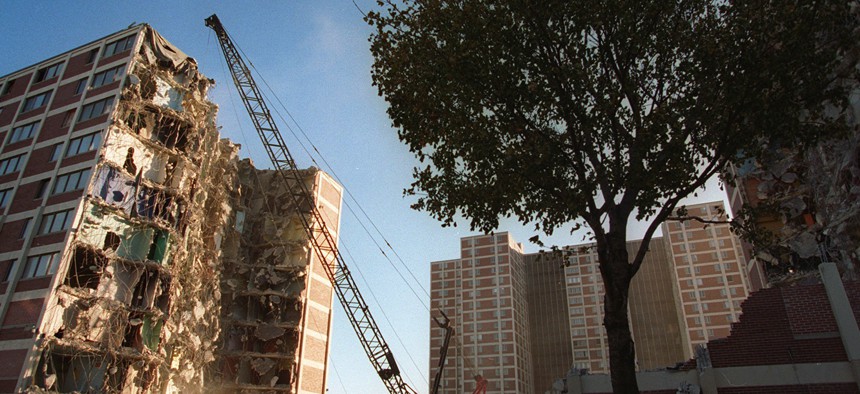Affordable Housing Can't Just Be a Local Priority, City Leaders Say

In this Wednesday, Nov. 8, 1995, file photo, a wrecking ball tears away at one of several Cabrini-Green public housing project buildings in Chicago. Beth A. Keiser/AP Photo

Connecting state and local government leaders
A new National League of Cities report lays out recommendations for the federal government and highlights steps individual cities have taken to address their housing needs.
As housing becomes less affordable to the average worker in cities across the United States, concern about the nation’s affordable housing crisis has pervaded discussions everywhere from the Democratic presidential campaign trail to Google’s campus.
Local efforts to create and preserve affordable housing only go so far, however, and should be met by a redoubling of investment by the federal government, a new report released Tuesday argues.
The National League of Cities issued the report to showcase affordable housing recommendations for federal and local governments, as well as to provide a template for cities to use when crafting policies to address their unique housing needs.
The report suggests the federal government appropriate $30 billion in funding for affordable housing, including $15 billion for the public housing capital program, and split the remaining $15 billion between various local grants and the national Housing Production Trust Fund.
Local lawmakers said one of the most pressing needs for federal involvement is the expansion and modernization of public housing. Speaking at a National League of Cities event on Tuesday, Washington, D.C. Mayor Muriel Bowser said the federal government needs a new paradigm for public housing.
“Walking away and privatizing it all is not something that has worked,” she said.
But replacing public housing creates its own unique challenges, said Karen Freeman-Wilson, the mayor of Gary, Indiana and president of the NLC.
Gary has about 600 units of public housing that needs to be replaced. If those units were torn down, the city would have problems finding homes for displaced residents and ensuring they had money to cover deposits in private rentals, Freeman-Wilson said.
By providing emergency rental assistance for those families in the short term, the federal government could also help prevent families from turning to public housing in the first place, Bowser said.
Affordable housing concerns are not restricted to public housing alone—middle class earners are also increasingly feeling the financial squeeze.
A recent survey of 480 U.S. counties found the median home price in 74 percent of counties was not affordable for the community’s average wage earner. Thirty-one percent of U.S. households are considered cost-burdened and spent more than 30 percent of their incomes on housing in 2017, according 2019 State of the Nation’s Housing report by the Harvard Joint Center for Housing Studies.
Factors including inadequate housing production, loss of low-income rentals, and income inequality have all contributed to the housing affordability problems nationwide, according to the report released last month by Harvard University.
The Harvard report found housing production “barely kept pace with household growth for most of the past decade.” Meanwhile, there are fewer affordable units on the market. The number of units renting for less than $800 dropped by 4 million units between 2011 and 2017, the study found.
To address current housing needs, the NLC report recommends the federal government dedicate consistent funding to the HOME grant program, which helps local governments construct affordable housing. Other recommendations include the establishment of a renter tax credit, federal homebuyer assistance targeted to small rural communities, and adoption of federal policies that aim to improve homeownership rates for historically segregated and disadvantaged communities.
The report also highlights steps local communities have taken to preserve or increase their affordable housing stock.
· To address vacant and dilapidated buildings, Peoria, Illinois, started a land-banking program that makes vacant city-owned properties available to developers who can meet certain criteria. Vacant lots adjacent to property owners’ homes are also considered for side-lot transfers that enable owners to increase the size of their property.
· Seattle, Washington required all new multi-family housing developments to reserve between 5 and 11% of planned units as rent restricted housing for low-income families.
· Bozeman, Montana standardized its codes for accessory dwelling units in order to make it easier for homeowners to rent out or construct existing space and to address the city’s high demand for housing.
· Minneapolis, Minnesota adopting a housing production plan that includes up-zoning in residential areas to allow for denser development.
“In order to make real progress in narrowing the gap in access to quality, affordable and safe housing, local leaders must take on the status quo and make significant structural alterations,” the report states. “City governments must provide tenants with legal support, prevent foreclosures, prioritize control over zoning by communities of color and create independent equitable development entities that put decision-making power over public investment in the hands of communities most at risk for displacement.”
Andrea Noble is a staff correspondent for Route Fifty.

NEXT STORY: Planning Transportation Projects Using 'Ultrasound for Roads'




